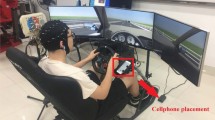Abstract
Driving was a complex human behavior not only including limb movements but also involving a lot of neuropsychological processes, such as perception, attention, learning, memory, decision making, and action control. Gamma rhythm had been linked with several cognitive functions such attention, memory and perception. In order to explore the understanding of the brain under the real environments, a driving simulator environment might be a best tool that stimulates the brain dynamic activity. The purpose of this study was to investigate cerebral gamma oscillatory differences in the frontal, temporal, parietal, and occipital regions associated with psychological processes during simulated car driving. Neurophysiological signals of 5 healthy volunteers were recorded by using electroencephalography (EEG) during resting and simulated driving, respectively. Oscillatory differences in the gamma band were calculated by comparison between “resting” and “driving”. “Resting” was the baseline, and oscillatory differences in the different regions during “driving” showed an increase in comparison with a baseline. The results indicated that brain oscillatory dynamics could play a role in cognitive processing, and might mediate the interaction between excitation and inhibition.
Access this chapter
Tax calculation will be finalised at checkout
Purchases are for personal use only
Similar content being viewed by others
References
Borghini, G., Astolfi, L., Vecchiato, G., Mattia, D., Bahiloni, F.: Measuring neurophysiological signals in aircraft pilots and car drivers for the assessment of mental workload, fatigue and drowsiness. Neurosci. Biobehav. Rev. 44, 58–75 (2014)
Laukka, S.J., Jarvilchto, T., Alexandrov, Y.I., Lindqvist, J.: Frontal midline-theta related to learning in a simulated driving task. Biol. Psychol. 40, 313–320 (1995)
Schier, M.A.: Changes in EEG alpha power during simulated driving: a demonstration. Int. J. Psychophysiol. 37, 155–162 (2000)
Kim, J.Y., Park, J.S., Lee, H.Y., Yoo, S.Y.: Analysis of psychologically optimal driving state through measurement of physiological signals. J. Korean Soc. Emot. Sensibility 7, 27–35 (2004)
Jäncke, L., Brunner, B., Esslen, M.: Brain activation during fast driving in a driving simulator: the role of the lateral prefrontal cortex. Neuroreport 19(11), 1127–1130 (2008)
Lin, C.-T., Chen, S.-A., Chiu, T.-T., Lin, H.-Z., Ko, L.-W.: Spatial and temporal EEG dynamics of dual-task driving performance. J. Neuroeng. Rehabil. 8, 11–23 (2011)
Zhao, C.L., Zhao, M., Liu, J.P., Zheng, C.X.: Electroencephalogram and electrocardiograph assessment of mental fatigue in a driving simulator. Accid. Anal. Prev. 45, 83–90 (2012)
Sonnleitner, A., Simon, M., Kincses, W.E., Buchner, A., Schrauf, M.: Alpha spindles as neurophysiological correlates indicating attentional shift in a simulated driving task. Int. J. Psychophysiol. 83, 110–118 (2012)
Fries, P.: Neuronal gamma-band synchronization as a fundamental process in cortical computation. Annu. Rev. Neurosci. 32, 209–224 (2009)
Ray, S., Maunsell, J.: Do Gamma oscillations play a role in cerebral cortex? Trends Cogn. Sci. 19(2), 78–85 (2015)
Kim, H., Hwang, Y., Yoon, D., Choi, W., Park, C.: Driver workload characteristics analysis using EEG data from an urban road. IEEE Trans. Intell. Transp. Syst. 15(4), 1844–1849 (2014)
Calhoun, V.D., Pearlson, G.D.: A selective review of simulated driving studies: combining naturalistic and hybrid paradigms, analysis approaches, and future directions. Neuroimage 59, 25–35 (2012)
Wang, Y., Chen, S., Lin, C.: An EEG-based brain-computer interface for dual task driving detection. Neurocomputing 129, 85–93 (2014)
Zhang, H., Chavarriaga, R., Khaliliardali, Z., Gheorghe, L., Iturrate, I., Millán, J.: EEG-based decoding of error-related brain activity in a real-world driving task. J. Neural Eng. 12, 066028 (2015)
Wade, J., Bian, D., Zhang, L., Swanson, A., Sarkar, M., Warren, Z., Sarkar, N.: Design of a virtual reality driving environment to assess performance of teenagers with ASD. In: Stephanidis, C., Antona, M. (eds.) UAHCI 2014, Part II. LNCS, vol. 8514, pp. 466–474. Springer, Heidelberg (2014)
Lei, M., Meng, G., Zhang, W.M., Sarkar, N.: Sample entropy of electroencephalogram for children with autism based on virtual driving game. Acta Phys. Sin. 65(10), 108701 (2016)
Acknowledgments
This work was funded by the Science Fund for Creative Research Groups of the National Natural Science Foundation of China (Grant No. 51421092), the National Natural Science Foundation of China (Grant No. 10872125), the Natural Science Foundation of Shanghai, China (Grant No. 06ZR14042), the Research Fund of State Key Laboratory of Mechanical System and Vibration, China (Grant No. MSV-MS-2010-08), the Research Fund from Shanghai Jiao Tong University for Medical and Engineering Science, China (Grant No. YG2013MS74), the NSF Project of USA (Grant Nos. 0967170, 1264462), and the NIH project of USA (Grant Nos. 1R01MH091102-01A1, 1R21MH103518-01).
Author information
Authors and Affiliations
Corresponding authors
Editor information
Editors and Affiliations
Rights and permissions
Copyright information
© 2016 Springer International Publishing Switzerland
About this paper
Cite this paper
Lei, M., Meng, G., Zhang, W., Wade, J., Sarkar, N. (2016). Brain Gamma Oscillations of Healthy People During Simulated Driving. In: Kubota, N., Kiguchi, K., Liu, H., Obo, T. (eds) Intelligent Robotics and Applications. ICIRA 2016. Lecture Notes in Computer Science(), vol 9835. Springer, Cham. https://doi.org/10.1007/978-3-319-43518-3_43
Download citation
DOI: https://doi.org/10.1007/978-3-319-43518-3_43
Published:
Publisher Name: Springer, Cham
Print ISBN: 978-3-319-43517-6
Online ISBN: 978-3-319-43518-3
eBook Packages: Computer ScienceComputer Science (R0)




